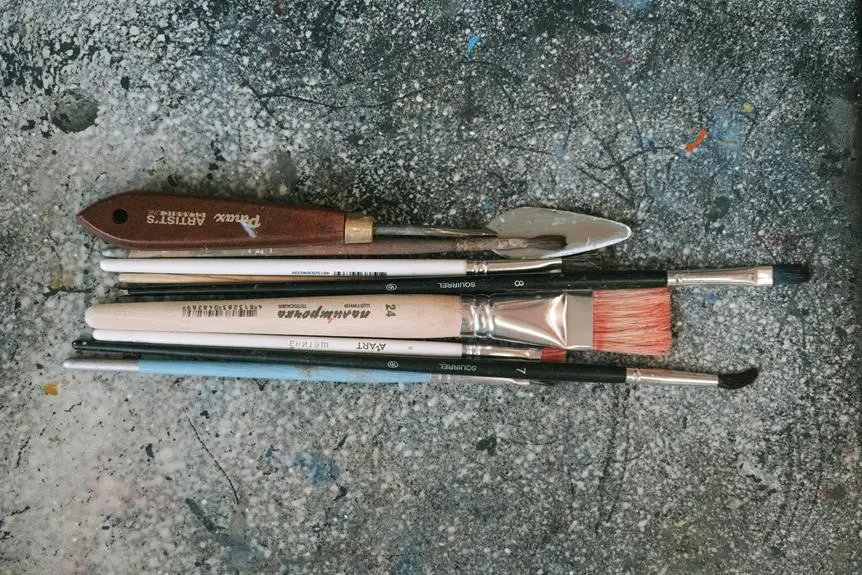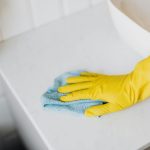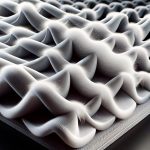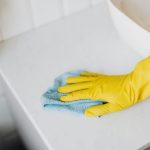When it comes to tackling stubborn stains, you need the right tools in your arsenal. Specialized stain remover solutions, microfiber cloths, and soft-bristled brushes can make a significant difference in your cleaning efforts. You'll find that having spray bottles for precise application and portable stain removal kits adds convenience to your routine. But what about those more challenging stains that require a deeper clean? The answer lies in a few additional tools that can elevate your cleaning game. Let's explore what these must-have items are and how they can help you achieve spotless results.
Table of Contents
Key Takeaways
- Effective stain removal requires specific solutions like enzymatic cleaners, heavy-duty degreasers, and natural options such as baking soda and vinegar.
- Microfiber cloths are essential due to their absorbency, softness, and eco-friendly nature, making them ideal for various surfaces.
- Utilizing soft brushes with appropriate bristle types helps lift stains without damaging fabrics, ensuring careful cleaning.
- Spray bottles with adjustable nozzles and measurement markings aid in accurately applying cleaning solutions for targeted stain removal.
Stain Remover Solutions
When tackling tough stains, having the right stain remover solutions at your disposal can make all the difference. You've got a variety of options to choose from, each designed to tackle specific types of stains.
For grease stains, a heavy-duty degreaser can cut through the oil effectively. If you're dealing with food stains, look for enzymatic cleaners that break down proteins and carbohydrates, making it easier to lift the stain from fabric or surfaces.
For ink stains, a rubbing alcohol solution works wonders. Just dab it on the stain and watch it lift away. If you're facing red wine spills, a combination of salt and club soda can neutralize the color before it sets in.
Don't forget about the power of baking soda and vinegar; they're versatile options for many stains, providing a natural approach to cleaning.
Always remember to test any solution on a small, inconspicuous area first to avoid damaging your fabrics. With the right stain remover solutions, you can tackle any mess with confidence and restore your items to their original condition.
Microfiber Cloths
Microfiber cloths are essential for effective stain removal, thanks to their unique properties.
You'll want to understand their benefits, learn the best cleaning techniques, and discover how to maintain them for long-lasting use.
Let's explore how these versatile tools can enhance your cleaning routine.
Benefits of Microfiber Cloths
These versatile cleaning tools effectively trap dust and grime, making your stain removal efforts faster and more efficient. Microfiber cloths are not only incredibly absorbent, but they also reduce the need for harsh chemicals, promoting a safer cleaning environment. You'll find they work wonders on various surfaces, from countertops to upholstery.
Here's a quick look at some key benefits of using microfiber cloths:
| Benefit | Description |
|---|---|
| Superior Absorption | Microfiber can absorb up to seven times its weight in liquid. |
| Scratch-Free Cleaning | The soft fibers ensure surfaces remain scratch-free while cleaning. |
| Eco-Friendly Option | Using microfiber reduces the need for chemical cleaners, making it better for the environment. |
Incorporating microfiber cloths into your stain removal toolkit not only enhances your cleaning routine but also helps you achieve better results. You'll appreciate how easy they make tackling tough stains, ensuring your surfaces look their best without damaging them. Give them a try, and you'll likely wonder how you ever cleaned without them!
Proper Cleaning Techniques
To effectively use microfiber cloths for stain removal, start by dampening the cloth with water or a suitable cleaning solution. Make sure it's not too wet, as excess moisture can spread the stain instead of lifting it.
Once your cloth is ready, gently blot the stained area. Avoid rubbing, as this could damage the fabric or push the stain deeper into the fibers.
For tougher stains, apply a bit of the cleaning solution directly to the cloth or the stain itself. Let it sit for a minute to break down the stain's components before you start blotting again. Use a clean section of the cloth for each blot, switching sides frequently to avoid reapplying the stain.
When dealing with larger stains, work from the outside toward the center to prevent spreading. Always test any cleaning solution on a hidden area first to ensure it won't damage the surface.
After you've lifted the stain, rinse the cloth thoroughly to remove residue, then allow it to air dry. This technique ensures you maximize the effectiveness of your microfiber cloths while protecting your surfaces.
Maintenance and Longevity Tips
Proper care of your microfiber cloths can significantly extend their lifespan and maintain their effectiveness for stain removal. To keep them in top shape, follow these simple maintenance tips.
First, always wash your microfiber cloths separately from other fabrics to avoid lint transfer. Use a mild detergent without fabric softeners, as these can clog the fibers and reduce their absorbency. Wash in warm water, and air dry or tumble dry on low heat to prevent damage.
Here's a quick reference table to help you remember the do's and don'ts:
| Do's | Don'ts | Frequency |
|---|---|---|
| Wash separately | Use bleach | After each use |
| Use mild detergent | Fabric softeners | When visibly soiled |
| Air dry or low heat | Iron the cloths | Every few washes |
Soft-Bristled Brushes
When tackling tough stains, using the right soft-bristled brush can make all the difference.
You'll want to explore different types of brushes, learn proper techniques for effective cleaning, and understand how to care for your tools.
Let's break down these key points to ensure you're equipped for success.
Types of Soft Brushes
Soft-bristled brushes are essential tools in your stain removal arsenal, offering gentle yet effective cleaning for delicate surfaces.
When choosing a soft brush, consider the type of bristles and their intended use. Synthetic bristles, like nylon or polyester, are durable and resistant to water, making them ideal for a variety of stains. They're perfect for scrubbing upholstery or carpets without damaging the fibers.
Natural bristles, such as those made from horsehair or boar hair, provide a softer touch and can be great for delicate fabrics or surfaces, ensuring you don't risk scratching or fraying. You might want to keep a few brushes of different sizes on hand. A small, handheld brush can reach into tight spots, while a larger brush is better suited for bigger areas, like carpets or rugs.
Also, consider the stiffness of the bristles. A medium-soft brush can tackle most stains effectively, while a softer brush is best for sensitive materials.
Proper Brush Techniques
Understanding how to use your soft-bristled brushes effectively can make a significant difference in your stain removal efforts. These brushes are gentle enough to avoid damaging delicate fabrics while still being effective in lifting stains.
Here are some key techniques to keep in mind:
- Apply the Right Pressure: Use light, consistent pressure to avoid fraying or tearing your fabric. Too much force can worsen the stain or damage the surface.
- Brush in Circular Motions: Instead of scrubbing back and forth, use small circular motions. This technique helps to lift the stain without pushing it deeper into the fibers.
Cleaning Brush Care
Caring for your soft-bristled brushes is essential to ensure they remain effective for stain removal and last longer.
After each use, rinse your brushes thoroughly under warm water to remove any soap, dirt, or debris. Avoid using hot water, as it can damage the bristles.
Next, use a mild soap or brush cleaner to gently lather the bristles, focusing on any stained areas. Rinse again until the water runs clear. Be careful not to pull or twist the bristles, as this can cause them to lose their shape.
Once cleaned, reshape the bristles with your fingers to ensure they stay uniform. Lay the brushes flat on a clean towel to dry, avoiding direct sunlight or heat sources that could warp the bristles.
Store your brushes upright in a holder or drawer to prevent them from getting crushed or bent. Regular cleaning and proper storage will extend the life of your brushes, allowing you to tackle stubborn stains effectively.
Spray Bottles
Using spray bottles for stain removal allows you to apply cleaning solutions evenly and effectively, making your task much simpler. These versatile tools help you control the amount of solution you use, preventing waste and ensuring that the stain gets the attention it needs. Plus, they're easy to handle and can be used in various situations around your home.
When choosing a spray bottle for stain removal, consider the following features:
- Adjustable Nozzle: Being able to change the spray pattern lets you switch from a fine mist to a steady stream, depending on the stain's nature.
- Clear Measurement Markings: This helps you mix solutions accurately, ensuring you get the right concentration for effective cleaning.
With the right spray bottle, you'll find stain removal easier and more efficient.
Just remember to label your bottles to avoid any confusion, and always test your cleaning solution on a small, inconspicuous area first to prevent damage.
Stain Removal Kits
Stain removal kits can simplify your cleaning routine by providing all the essential tools and solutions in one convenient package. When a spill happens, you won't waste time searching for individual products; everything you need is right at your fingertips.
These kits typically include stain removers, absorbent cloths, and brushes, tailored for different types of stains. Whether you're tackling grease, wine, or ink, having a designated kit helps you act quickly and effectively. Most kits contain clear instructions on how to use each item, ensuring you can address stains with confidence.
You'll also find portable options in many kits, making it easy to take them along for picnics or road trips. This way, you're always prepared for unexpected spills. Additionally, some stain removal kits are eco-friendly, offering powerful solutions that are safe for your family and the environment.
Investing in a comprehensive stain removal kit streamlines your cleaning process, saving you time and effort. You'll be amazed at how quickly you can tackle stains, keeping your home looking fresh and clean without the hassle. So, grab a kit, and be ready for whatever life throws your way!
Carpet Cleaners
Having the right tools for cleaning up spills is important, but when it comes to deeper messes on carpets, dedicated carpet cleaners can make all the difference. These machines are designed to tackle tough stains and odors, ensuring your carpets look fresh and clean. Investing in a quality carpet cleaner will save you time and effort while providing impressive results.
Here are three key features to look for when choosing a carpet cleaner:
- Strong Suction Power: This helps lift dirt and stains from deep within the carpet fibers, ensuring a thorough clean.
- Multiple Cleaning Modes: Select a machine that offers various settings for different types of stains or carpet materials, giving you versatility for every situation.
With the right carpet cleaner, you can tackle stubborn stains efficiently, keeping your home looking its best.
Protective Gloves
When tackling tough stains, donning a pair of protective gloves can safeguard your hands from harsh chemicals and messes.
Whether you're using a commercial cleaner or a homemade solution, these gloves act as a barrier, keeping your skin safe from irritation and potential allergic reactions.
Choose gloves that fit well; ill-fitting ones can hinder your ability to grip tools effectively.
Latex gloves are popular for their dexterity, but if you have a latex allergy, opt for nitrile or vinyl alternatives. Each type offers a different level of protection, so think about the specific stains you're dealing with and select gloves accordingly.
Don't forget to check the gloves for any rips or tears before you start cleaning. Even a small hole can expose your skin to harmful substances.
After you've finished cleaning, remove your gloves carefully to avoid contact with the contaminated surfaces.
Frequently Asked Questions
Can I Use Vinegar for All Types of Stains?
You can use vinegar for many stains, but it's not effective for every type. It works well on grease, coffee, and some food stains, but avoid using it on delicate fabrics or certain surfaces.
How Do I Store Homemade Stain Remover Solutions?
To store homemade stain remover solutions, pour them into clean, labeled spray bottles. Keep them in a cool, dark place, away from direct sunlight. Remember to shake well before each use for best results.
Are There Eco-Friendly Stain Removal Tools Available?
Yes, there are eco-friendly stain removal tools available. You can find biodegradable sponges, natural bristle brushes, and reusable cloths that won't harm the environment. These options help you tackle stains sustainably while keeping your conscience clear.
What Fabrics Should I Avoid Using Brushes On?
You should avoid using brushes on delicate fabrics like silk, lace, and velvet. These materials can easily get damaged or frayed, so stick to gentler cleaning methods to keep your fabrics looking their best.
How Often Should I Replace My Microfiber Cloths?
You should replace your microfiber cloths every six months to a year, depending on how often you use them. Regular inspection for wear and tear can help you determine when it's time for a replacement.
- How Does Ring Spun Cotton Affect Garment Fit and Shape Retention? - August 13, 2024
- What Are the Challenges in Producing Ring Spun Cotton? - August 13, 2024
- Is Ring Spun Cotton Suitable for Plus-Size Clothing? - August 13, 2024







